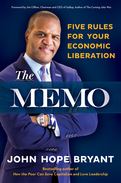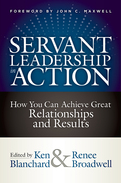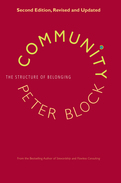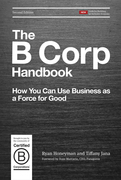Search Results: "Social Venture Networks/books/marketing-that-matters.htm"
Results 181-186 of 345
Your Best Prospects Are Referred Prospects!
Nobody likes cold calls. And nobody really needs to make them. The Referral of a Lifetime teaches a step-by-step system that will allow anyone to generate a steady stream of new business through consistent, qualified referrals while retaining and maximizing business with existing customers. Tim Templeton emphasizes the importance of applying the golden rule in business—putting the relationship with your customer first, rather than just making the sale.
This second edition adds a technique for creating a profile of your ideal customer and explains how to reach the tipping point on online reviews and testimonials so you can expand your business 24/7. Your customers, colleagues, and friends already know every new contact you will ever need to succeed. When you apply Tim Templeton's system, they will naturally refer those potential new customers to you.
Nobody likes cold calls. And nobody really needs to make them. The Referral of a Lifetime teaches a step-by-step system that will allow anyone to generate a steady stream of new business through consistent, qualified referrals while retaining and maximizing business with existing customers. Tim Templeton emphasizes the importance of applying the golden rule in business—putting the relationship with your customer first, rather than just making the sale.
This second edition adds a technique for creating a profile of your ideal customer and explains how to reach the tipping point on online reviews and testimonials so you can expand your business 24/7. Your customers, colleagues, and friends already know every new contact you will ever need to succeed. When you apply Tim Templeton's system, they will naturally refer those potential new customers to you.
The Memo
2017
True power in this world comes from economic independence, but too many people have too much month left at the end of their money. John Hope Bryant, founder and CEO of Operation HOPE, illuminates the path toward liberation that is hiding in plain sight. His message is simple: the supermajority of people who live in poverty, whom Bryant calls the invisible class, as well as millions in the struggling middle class, haven't gotten “the memo”—until now.
Building on his personal experience of rising up from economically disadvantaged circumstances and his work with Operation HOPE, Bryant teaches readers five rules that lay the foundation for achieving financial freedom. He emphasizes the inseparable connection between “inner capital” (mindset, relationships, knowledge, and spirit) and “outer capital” (financial wealth and property). “If you have inner capital,” Bryant writes, “you can never be truly poor. If you lack inner capital, all the money in the world cannot set you free.”
Bryant gives readers tools for empowerment by covering everything from achieving basic financial literacy to investing in positive relationships and approaching wealth with a completely new attitude. He makes this bold and controversial claim: “Once you have satisfied your basic sustenance needs—food, water, health, and a roof over your head—poverty has more to do with your head than your wallet.”
Bryant wants to restore readers' “silver rights,” giving them the ability to succeed and prosper no matter what very real roadblocks society puts in their way. We have more power than we realize, if only we can recognize and claim it. “We are our first capital,” Bryant writes. “We are the CEOs of our own lives.”
Building on his personal experience of rising up from economically disadvantaged circumstances and his work with Operation HOPE, Bryant teaches readers five rules that lay the foundation for achieving financial freedom. He emphasizes the inseparable connection between “inner capital” (mindset, relationships, knowledge, and spirit) and “outer capital” (financial wealth and property). “If you have inner capital,” Bryant writes, “you can never be truly poor. If you lack inner capital, all the money in the world cannot set you free.”
Bryant gives readers tools for empowerment by covering everything from achieving basic financial literacy to investing in positive relationships and approaching wealth with a completely new attitude. He makes this bold and controversial claim: “Once you have satisfied your basic sustenance needs—food, water, health, and a roof over your head—poverty has more to do with your head than your wallet.”
Bryant wants to restore readers' “silver rights,” giving them the ability to succeed and prosper no matter what very real roadblocks society puts in their way. We have more power than we realize, if only we can recognize and claim it. “We are our first capital,” Bryant writes. “We are the CEOs of our own lives.”
Edited by legendary business author Ken Blanchard and featuring contributions by authors like Simon Sinek, Bren Brown, Stephen M. R. Covey, and Marshall Goldsmith, this collection offers expert advice on how to implement an increasingly popular and highly effective approach to leadership.Edited by legendary business author Ken Blanchard and featuring contributions by authors like Simon Sinek, Bren Brown, Stephen M. R. Covey, and Marshall Goldsmith, this collection offers expert advice on how to implement an increasingly popular and highly effective approach to leadership.
Servant leadership is the secret behind the success of some of the world's leading organizations. Succinctly put, serving leaders lead by serving their people, not by exalting themselves.
Through the stories and reflections of leading businesspeople, bestselling authors, and spiritual leaders, this collection offers tools for implementing this proven but radical leadership model. The book is organized into three sections:
-What is Servant Leadership? describes different aspects of servant leadership
-Models of Servant Leadership focuses on people who have been identified as classic servant leaders
-Putting Servant Leadership to Work features firsthand accounts of how servant leadership has been implemented in various organizations and the difference it has made in both results and human satisfaction.
Servant leadership is the secret behind the success of some of the world's leading organizations. Succinctly put, serving leaders lead by serving their people, not by exalting themselves.
Through the stories and reflections of leading businesspeople, bestselling authors, and spiritual leaders, this collection offers tools for implementing this proven but radical leadership model. The book is organized into three sections:
-What is Servant Leadership? describes different aspects of servant leadership
-Models of Servant Leadership focuses on people who have been identified as classic servant leaders
-Putting Servant Leadership to Work features firsthand accounts of how servant leadership has been implemented in various organizations and the difference it has made in both results and human satisfaction.
Greatness Redefined for the 21st Century
Today's business climate is defined by speed, social technologies, and people's expectations of “values” besides value. As a result, leaders have to create an outstanding culture for all, no matter who they are or what they do for the organization. This groundbreaking book, from the creators of the gold-standard Fortune 100 Best Companies to Work For list, shows how it's done. Through inspiring stories and compelling research, the authors demonstrate that great places to work for all benefit the individuals working there and contribute to a better global society—even as they outperform in the stock market and grow revenue three times faster than less-inclusive rivals. This is a call to lead so that organizations develop every ounce of human potential.
Today's business climate is defined by speed, social technologies, and people's expectations of “values” besides value. As a result, leaders have to create an outstanding culture for all, no matter who they are or what they do for the organization. This groundbreaking book, from the creators of the gold-standard Fortune 100 Best Companies to Work For list, shows how it's done. Through inspiring stories and compelling research, the authors demonstrate that great places to work for all benefit the individuals working there and contribute to a better global society—even as they outperform in the stock market and grow revenue three times faster than less-inclusive rivals. This is a call to lead so that organizations develop every ounce of human potential.
Community
2018
As a response to the increasing violence in our culture, the widening ideological divides, and the growing gap in economic well-being, there is greater awareness that a deeper sense of community is desperately needed. But even as we acknowledge the need to build community, the dominant on-the-ground practices about how to engage people, civically and organizationally, remain essentially unchanged. We still believe community is built with better messaging, more persuasion, and social events for people to get to know each other better. All of which is naïve.
In this new edition, Block draws on a decade of putting these ideas into practice to emphasize what has worked and extract those thoughts that were nice but had no durability. He explores how technology, instead of bringing us together, has driven us into more isolation. New examples show that community building can be a more powerful way to address social problems than more traditional policies and programs. And encouragingly, Block insists this is really simple, once we decide it is essential. He offers a way of thinking that creates an opening for authentic communities to exist and details what each of us can do to make that happen.
In this new edition, Block draws on a decade of putting these ideas into practice to emphasize what has worked and extract those thoughts that were nice but had no durability. He explores how technology, instead of bringing us together, has driven us into more isolation. New examples show that community building can be a more powerful way to address social problems than more traditional policies and programs. And encouragingly, Block insists this is really simple, once we decide it is essential. He offers a way of thinking that creates an opening for authentic communities to exist and details what each of us can do to make that happen.
“This book shows how using business as a force for good, not just pursuing short-term profits, can be better for consumers, employees, local communities, the environment, and your company's long-term bottom line.”
—Tony Hsieh, New York Times bestselling author of Delivering Happiness and CEO, Zappos.com, Inc.
B Corps are a global movement of more than 2,700 companies in 60 countries—like Patagonia, Ben & Jerry's, Kickstarter, Danone North America, and Eileen Fisher—that are using the power of business as a force for good. B Corps have been certified to have met rigorous standards of social and environmental performance, accountability, and transparency. This book is the authoritative guide to the what, why, and how of B Corp certification.
Coauthors Ryan Honeyman and Dr. Tiffany Jana spoke with the leaders of over 200 B Corps from around the world to get their insights on becoming a Certified B Corp, improving their social and environmental performance, and building a more inclusive economy. The second edition has been completely revised and updated to include a much stronger focus on diversity, equity, and inclusion (DEI). These changes are important because DEI can no longer be a side conversation—it must be a core value for any company that aspires to make money and make a difference.
While this book is framed around the B Corp movement, any company, regardless of size, industry, or location, can use the tools contained here to learn how to build a better business. As the authors vividly demonstrate, using business as a force for good can help you attract and retain the best talent, distinguish your company in a crowded market, and increase trust in your brand.
—Tony Hsieh, New York Times bestselling author of Delivering Happiness and CEO, Zappos.com, Inc.
B Corps are a global movement of more than 2,700 companies in 60 countries—like Patagonia, Ben & Jerry's, Kickstarter, Danone North America, and Eileen Fisher—that are using the power of business as a force for good. B Corps have been certified to have met rigorous standards of social and environmental performance, accountability, and transparency. This book is the authoritative guide to the what, why, and how of B Corp certification.
Coauthors Ryan Honeyman and Dr. Tiffany Jana spoke with the leaders of over 200 B Corps from around the world to get their insights on becoming a Certified B Corp, improving their social and environmental performance, and building a more inclusive economy. The second edition has been completely revised and updated to include a much stronger focus on diversity, equity, and inclusion (DEI). These changes are important because DEI can no longer be a side conversation—it must be a core value for any company that aspires to make money and make a difference.
While this book is framed around the B Corp movement, any company, regardless of size, industry, or location, can use the tools contained here to learn how to build a better business. As the authors vividly demonstrate, using business as a force for good can help you attract and retain the best talent, distinguish your company in a crowded market, and increase trust in your brand.

















